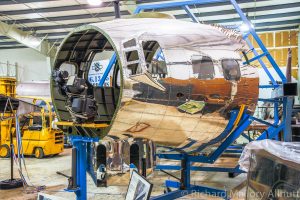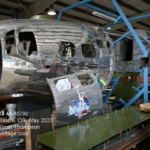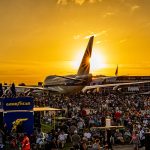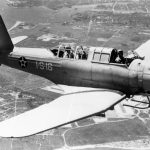By Adam Estes
Throughout aviation history, there have been many unusual applications that airplanes have found themselves in, and vintage aircraft are no different. Perhaps the most unusual of these is the use of surplus aircraft as part of gas stations. These aircraft usually being brought to the site by a business-savvy entrepreneur set on attracting more customers by adding such a curiosity as an airplane or a helicopter to the roof of their gas/service station.

For nearly 70 years, one of the most iconic gas station airplanes in the United States could be found in Milwaukie, Oregon, near Portland, serving as a local landmark known simply as “the bomber”. The bomber in question, however, was none other than a Boeing B-17G Flying Fortress that came to be known as the Lacey Lady. How the Lacey Lady came to Milwaukie is a story in itself, involving a birthday bet and the efforts by an ordinary man to put a B-17 on his gas station. In 1947 Art Lacey was celebrating his 34th birthday, and as the party became more social, Lacey declared that he would buy a B-17 and place it atop his gas station. A friend told him that he couldn’t get it done, and as Art’s daughter Punky Scott would recall years later, “My dad was the kind of fellow who if you said ‘No, you can’t do something’, he was going to prove you wrong…”
After some banter, Lacey made a $5 bet to his friend that he could get a B-17 and bring it back to the gas station. When he turned to another friend asking for money to purchase a surplus B-17, Lacey said that he needed $15,000 (roughly equivalent to $210,906.73 in 2024). Incredibly, Lacey’s friend had the money on him! (At that time, business in nearby Portland was booming, including the trades of vice, from gambling to illegal alcohol.) Now that he had the bet and the money, Art went to the Army Airfield at Altus, Oklahoma, where the Reconstruction Finance Corporation (RFC) was selling B-17s, either for private individuals or for scrap dealers. Lacey was a charming man and was able to convince the base commander to let him take a B-17 that he was interested in for a test flight, as he was a pilot.

One thing that Lacey neglected to mention, however, was that although he was a pilot, he was not rated for multi-engine aircraft, and had never flown a B-17 before. Nevertheless, with a mannequin in the copilot’s seat, he took off, raised the landing gear, and got a feel for the controls. So far, all was going well, but when he came in to land back at Atlus, the landing gear had malfunctioned, and he could no longer lower the gear. With no other options, Lacey prepared for a wheels-up landing. Skidding across the field, the B-17 veered off the runway and crashed into another B-17. In Lacey’s own words, “Instead of one crashed B-17, I got two”. Today, such a story would have received front-page news, but the base commander was sympathetic to Lacey, and wrote the damage off as being related to damage from high winds, something not at all unheard of for Oklahomans.
Lacey was also lucky that the sale of the B-17 was not finalized, and as it turned out, that B-17 had also seen some action during the war and was now no longer in the best condition for a B-17. To reconcile Lacey, the base commander at Altus let him have another B-17, which turned out to be a newly-built B-17G, USAAF serial number 44-85790. Constructed at the Lockheed-Vega Aircraft Company in Burbank, California, 44-85790 was accepted into the US Army Air Force on June 13th, 1945 as one of the very last B-17s to leave the production lines. From there the bomber was flown to Lockheed’s Modification Center #3 at Love Field in Dallas, Texas on June 16th via stopovers in Long Beach and Palm Springs, California to receive additional equipment for military purposes. Next, the aircraft found itself at several Army Airfields across the country, from Rome, New York to Cincinnati, Ohio, to Independence, Kansas before ending up at Altus in November 1945, one of many planes to go from the factories to the scrapyards at the end of the war.

Now accompanied by friends Bob Sturges and George Fuller, Lacey and his companions would set off with 44-85790 for Portland on March 8th, 1947. They made several stops to refuel and rest along the way, but by March 10th, they had successfully flown the surplus B-17 to Portland-Troutdale Airport. But although 44-85790 was in the Portland area, the aircraft still needed to be disassembled and trucked to the service station. The problem was that even disassembled, the aircraft would be deemed too heavy, too high, and too wide to go down the two-lane roads. But Lacey decided that if he could drive the bomber to Milwaukie under the cover of night, he might just be able to slip by without attracting the attention of the local police. So he hired two motorcyclists to accompany the convoy, with the instructions that if the police got involved, the motorcyclists were to split off. Lacey suffered no issues during the twenty-mile drive, but a tipsy driver was forced to drive into a ditch when he saw the bomber coming down the two-lane road!
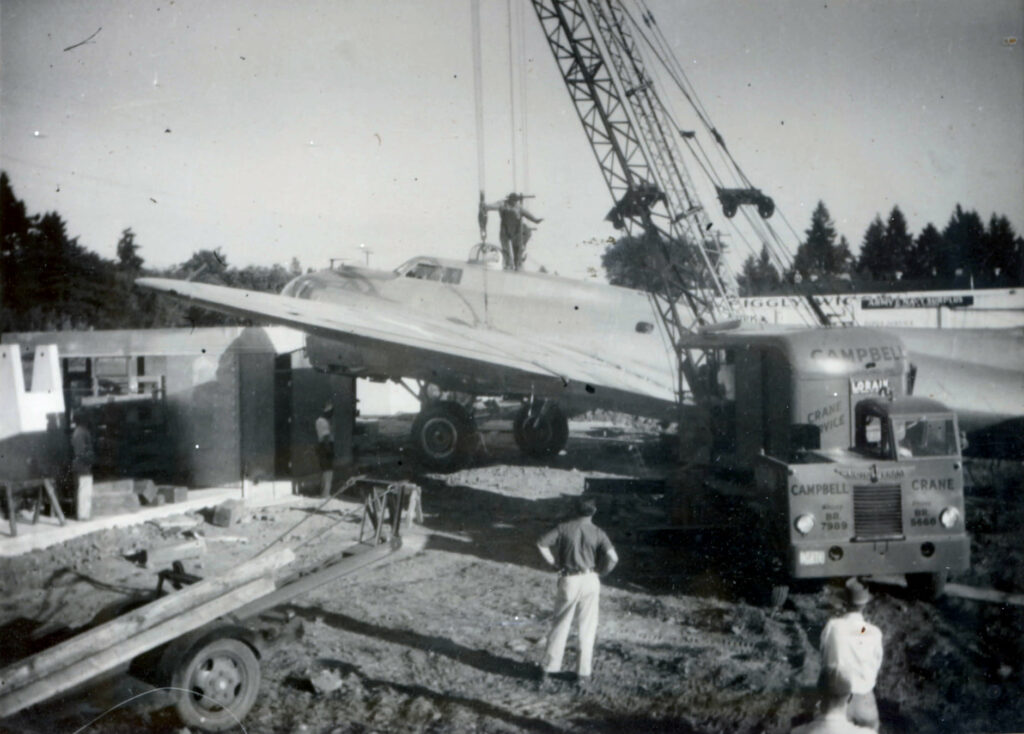
Once the bomber arrived and was reassembled, Lacey attracted the ire of local officials for not securing permits for the oversized load, but the Oregon Journal newspaper got wind of the story and spun a story of the local government attempting to forcefully take away the surplus bomber. With the war having ended only two years prior, and local patriotism surging, the officials didn’t want to endure further bad press but determined that Lacey should still be fined. When the case landed on the desk of the local judge in Milwaukie, he decided that Lacey’s penalty should be a mere $10.00 fine. With that, Lacey was the proud owner of a B-17 Flying Fortress!

Over the years, the plane became a local legend, with kids getting to play inside the cockpit, and many local teenagers made their first paychecks filling gas under the wings of the old bomber. Later on, Art and his wife Birdine moved the bomber and the gas station to a new location during the 1960s, and when the gas station eventually closed, the Lacey family ran a nearby restaurant called The Bomber. However, the years were not kind to the aircraft. It suffered from vandals breaking in and stealing parts, and the aircraft also became a source of spare components for other B-17s. During the 1960s, the Sperry ball turret was donated to the local AMVETS chapter in Tulare, California, and installed on B-17G 44-85738, which still sits off Highway 99 in Tulare. The top turret was removed to be reinstalled on a former fire tanker flown by the Commemorative Air Force, the B-17G Sentimental Journey, in exchange for the installation of a fiberglass turret and cosmetic exterior restoration.
By the 1990s, however, as Art and Birdine were growing old, he and his grandson Jayson Scott organized a “Bomber Restoration Project”, with Jayson establishing a nonprofit organization. On March 23rd, 1996, the nose and cockpit sections were removed and sent to Aurora Airport, where restorer Shane Wease and his Vintage Aircraft Restoration Co. spent three years rebuilding and reskinning the nose, which was later displayed inside the restaurant to attract fundraising from patrons. The aircraft also adopted the name Lacey Lady for the first time, and artwork was designed by artist Mark Utz for application to the nose when the project was to be completed. However, the work on the cockpit section was halted due to a lack of funds, and in 2000, Art Lacey passed away. But despite these hardships, Lacey’s children and grandchildren pushed ahead to fulfill Art’s dream — which was now their dream — to make the Lacey Lady fly again.

By 2014, the B-17 Alliance Foundation had gained more of a foothold, and in August of that year, the Lacey Lady was finally taken down after being suspended in the air for sixty-seven years. Today, the aircraft is under restoration at the Salem Regional Airport. While the project still has a ways to go before 44-85790 will fly again, the B-17 Alliance Foundation is determined to achieve its long-term goal, which would not be possible were it not for a birthday party bet to put a B-17 on a gas station. You can read additional articles about this airplane right here on Vintage Aviation News. To support this restoration, visit www.b17alliance.com.
From Oregon, we venture to the Devland district of Soweto near Johannesburg, South Africa. There you are bound to find the sprawling wings of an Avro Shackleton perched above a Sasol service station, formerly known as Vic’s Viking Garage. Adorned in once bright yellow, blue, and white colors, with the tagline “Sasol Delight!” painted on its nose, there is little to indicate to the non-enthusiast its former life as a maritime patrol aircraft in the South African Air Force (SAAF). Named for the famed Antarctic explorer Sir Ernest Shackleton, the Avro Shackleton was a development of the Avro Lincoln bomber, which itself was a development of the famous Avro Lancaster bomber of WWII. But while the Lancaster and the Lincoln were intended for strategic bombing, the Shackleton was built from the start as a maritime patrol bomber. During the Cold War the Shackleton was a key tool in the British Royal Air Force (RAF) and the SAAF, searching for Soviet warships and submarines from the Arctic to the Antarctic oceans and the North Sea. With its four Rolls-Royce Griffon engines, each equipped with a set of contra-rotating propellers, the Shackleton was also among the last piston-engine military aircraft in active duty.

The Shackleton on top of this service station was originally built in England as an MR.3 variant as construction number 1533 and made its first flight on February 12th, 1958. C/N 1533 was to become one of the eight Shackletons destined for the SAAF, and was ferried to South Africa on February 14th, joining No.35 Squadron where it received the fuselage code ‘Q’ and would fly its missions out of Air Force Base Ysterplaat, near Cape Town. Not long into its service life, SAAF 1723 would suffer an in-flight hydraulic failure. Using the emergency release systems, the crew was able to lower the plane’s landing gear and flaps but had no authority over the aircraft’s brakes. Upon landing, SAAF 1723 ran off the runway and collided with a brick building. Fortunately, there were no fatalities, and the aircraft was returned to service, being progressively upgraded the longer it remained in service. As the Shackletons wore on, though, South Africa struggled to obtain spare parts to maintain the aging patrol bombers due to a global embargo on the country over the Afrikaaner-led government’s policy of apartheid. On November 22, 1977, SAAF 1723 was officially grounded and kept in storage at Ysterplaat, while the last of the South African Shackleton would remain in service until 1984. On March 5th, 1987, SAAF 1723 was brought to its present location, but in doing so, it also played a role in the preservation of another large aircraft that had previously been perched upon the service station, a Vickers Viking airliner, which is now the last of its kind preserved in South Africa.

Developed from the Vickers Wellington bomber of WWII, the Vickers VC.1 Viking was an important design in postwar British commercial aviation. This aircraft type was first flown in June 1945 and saw service as both military transports/trainers and short-haul civilian airliners from the late 1940s to the 1960s, when turbojet and turboprop airliners began to gradually replace the old piston-engined Vikings. Ironically, at least one example had served as a testbed for the Rolls-Royce Nene jet engine on commercial aircraft, paving the way for such aircraft as the world’s first turbojet airliner, the de Havilland DH.106 Comet. The example in South Africa was built at the Vickers-Armstrong plant in Weybridge, England as a Viking 1A, construction number 121. The 1A model was also a blend of old and new, with the outer sections of its wings being fabric, covering a geodesic frame similar to that on the old Wellington bombers, while the leading edges were made of curved aluminum. Immediately registered as G-AHOT with British European Airways (BEA), this Viking made its first flight on August 30, 1946, and would reportedly be used in support of the Berlin Airlift.

Eventually, the aircraft was transferred to Trek Airways in South Africa on September 26th, 1954, being assigned the South African civil registry ZS-DKH but was flown with the markings of Protea Airways, a subsidiary of Trek Airways. While it would fly many passengers all over South Africa and to destinations abroad, this particular aircraft was also famous for flying the American singer Jim Reeves during his tour of South Africa and his time during the production of the South African musical film Kimberley Jim in 1962. By the end of that year, ZS-DKH was retired from service, and on December 18th, 1962, the aircraft made its final flight from Rand Airport in Germiston to Baragwanath Airfield near Westonaria, just southwest of Soweto, a flight that was a short hop for the old airliner, covering about 40 kilometers (25 miles) of ground between Rand and Baragwanath. At the time the aircraft landed at Baragwanath, ZS-DKH had accumulated 13,881 hours of flight time. It was from there that the aircraft was acquired by service station owner Victor Edward de Villiers, known to those who knew him as “Vic”, and in January 1963, the Viking was mounted atop Vic’s service station in Devland, and soon the service station came to be called Vic’s Viking Garage.
From 1963 to 1987, the Viking became a local landmark for passersby and locals, alike. When holes appeared in the fabric surfaces of the wing, Vic would rivet sheets of aluminum to the wing to cover the holes. March 5th, 1987 would see the culmination of a trade deal between de Villiers, the South African Air Force, and the South African Airways Museum Society, where the SAAMS received Vic’s old Viking, while the retired SAAF Shackleton SAAF 1723 would take its place atop the service station. The wings of the Viking were removed, and the aircraft was towed to Jan Smuts Airport in Johannesburg for restoration to static display. However, the aircraft’s condition required an extensive restoration that in turn would require funds that the SAAMS did not have, and along with the Society’s Constellation and Junkers Ju 52, the Viking sat at Jan Smuts Airport until the South African Airways Museum Society began moving its static collection of airliners to Rand Airport. Interest in moving the Viking surged yet again, and in January 2017, the Vickers Viking was loaded onto a flatbed truck and driven to Rand Airport. Sadly, Victor Edward de Villiers passed away in 2015, but his children watched on as their father’s old airliner was moved to Rand Airport for the first time in 54 years. Today, the aircraft has taken on its old Protea Airways colors, receiving its stripes in August of 2023, though it appears quaint sitting next to the museum’s Boeing 747SP! ZS-DKH is now one of only six intact Vickers Vikings in the entire world, and the only one in South Africa, thanks to the efforts of Victor Edward de Villiers.

Perhaps one of the most colorful aircraft to have ever adorned the top of a gas station was a former Royal Canadian Air Force Curtiss Kittyhawk. Originally issued with the RAF serial AK899, this Kittyhawk Mk I (equivalent to a USAAF P-40D) was accepted into service with the RCAF on November 6, 1941. The aircraft spent much of WWII assigned to No 111 (F) Squadron (F standing for Fighter), based at RCAF Station Patricia Bay, British Columbia, now Victoria International Airport. While RCAF 1051 never fired a shot in anger, it endured no less than three incidents while in service, from a ground loop on June 9th, 1943, from an oleo leg collapse to the blast tube of the outboard gun on the left wing coming loose from its moorings on November 1st to a brake failure on November 15th causing the tail to lift on landing and causing a prop strike with the runway.
However, 1051 survived intact long enough to remain in service with the RCAF until it was stricken from the inventory on August 23rd, 1946. With a demand for surplus aircraft, Canada soon became a place for many Americans to purchase freshly retired Kittyhawks/P-40s, and Fred Dyson of Seattle would purchase several former RCAF Kittyhawks for importation back to the United States. On October 23rd, 1947, Dyson purchased Kittyhawk 1051 for the princely sum of $50 USD, and transported the aircraft to Boeing Field, Seattle via barge from Victoria, British Columbia. Within the next year, Dyson sold the aircraft to Tony Dire, who owned a Flying A service station in Everett, just north of Seattle, where the Kittyhawk was given a Flying Tigers-inspired look and an electric motor was installed to rotate the propeller as the aircraft sat atop the shop in downtown, becoming a local landmark for the next twenty years.

By February of 1968 RCAF 1051 was acquired by Robert Goessling of Unlimited Aircraft Inc., based in Chino, CA, where the old Kittyhawk would be transported to Chino Airport for restoration. The aircraft’s road back to the skies, however, would be marked by its title being owned by numerous individuals over the years, from M.E. Batchelor to David Tallichet to John C. Pearl before the aircraft came into the hands of Brian O’Farrell of Miami, Florida. Mr. O’Farrell then sold it to the man who would finally return the aircraft, now marked with the civil registry as N9837A, back to airworthiness. This was Richard W. Hansen of Batavia, Illinois, who had the aircraft restored at Rock County Airport (now Southern Wisconsin Regional Airport) in Janesville, Wisconsin, where on February 1st, 1992, the aircraft made its first flight in nearly 50 years.
For the next 20 years, the aircraft would be present at airshows on the US East Coast in US Army Air Corps markings with a typical shark’s mouth that many P-40s tend to have as part of their livery. The aircraft also carried the name “Old Exterminator”, and would even be temporarily based at the EAA Aviation Museum in Oshkosh, Wisconsin. In 2006, the aircraft was re-registered as N740RB with Leestown Aviation Warhawk, Inc, but would be flown out of Brookhaven Airport in Shirley, Long Island, New York. Sadly, the story of RCAF 1051 would come to a tragic end when, on April 5th, 2009, pilot Bob Baranaskas was prepared for an upcoming airshow by performing aerobatics off the coast of Fire Island, one of the barrier islands off the Long Island shore. During the maneuvers, Bob and the P-40 crashed into the Atlantic just off Fire Island. Bob Baranaskas, a friend to all he met in the warbird community, was tragically lost in the accident, and with him an airframe with a remarkable story.

Down in New Zealand, a favorite site for travelers and locals alike in Mangaweka, along State Highway 1 in the North Island, was a Douglas DC-3. This DC-3 started life as a C-47B with the American serial number 45-964, being accepted into the USAAF on July 24, 1945, before its immediate transfer to the Royal New Zealand Air Force, where it was brought on charge on August 21, 1945, and identified as a Dakota with the RNZAF serial number NZ3556. Having flown with No.40 Squadron and No.41 Squadron RNZAF, the aircraft was stricken from the RNZAF inventory on May 31, 1947, after its conversion to a DC-3D by Australian National Airways (ANA). Upon retirement from active duty, it received the New Zealand civil registry of ZK-APK. The aircraft was then used as an airliner for New Zealand National Air Corporation from 1947 to 1962, accumulating a total of 28,711 flight hours. From May to October 1967, ZK-APK was leased to Fiji Airways as VH-FAH before returning to New Zealand. 1969 would see ZK-APK converted for aerial topdressing (crop dusting) and used for agricultural purposes in New Zealand.

It would perform this work for Airland and Fieldair Ltd until 1981 when the aircraft was withdrawn from use after logging a total of 42,764 flying hours. After sitting idle for a few years, the aircraft was towed to Mangaweka, where it would be the home of a tearoom attached to an adventure excursion business. It would become a landmark on New Zealand’s State Highway 1, sporting a variety of colors, from the sponsored “Cookie Time DC-3”, to the “Mangaweka Skyliner”. But in 2021, the aircraft, having sat outside for the better part of 35 years, was moved to Shannon (some 112 kilometers to the southwest) for a promised restoration and return to Mangaweka for covered display. While the odd passerby could still find the Dakota in public view sitting wingless and engineless atop several shipping containers while the ambitious project seemingly stalled, the aircraft was then listed to potential buyers for varying amounts and at one point was stated to be airworthy. Finally, in mid-2024 an anonymous buyer stepped up and transported the aircraft to Auckland, where it is apparently destined to become boutique accommodation.

Having an airplane as the center of a gas station was not a new concept that originated with surplus military aircraft of the Second World War. If you needed to fill up while driving down Wilshire Boulevard in 1930s downtown Los Angeles, you could pull in under the massive wings of a Fokker F-32 airliner to Bob’s Air Mail Service Station. Largely forgotten in most circles, the Fokker F-32 was built by the Fokker Aircraft of America Corporation (or Atlantic-Fokker), the American division of the company founded by Dutch designer Anthony Fokker, and first flown in 1929. The F-32 was notable for being the first four-engined passenger airliner to enter service in the United States, with power provided by four Pratt & Whitney R-1860 Hornet radials in a push-pull configuration, with a forward-facing and rearward-facing engine sharing a nacelle under each wing. Like many Fokker transports, it was built with a large wooden wing, with a tubular metal framework covered in doped fabric. The aircraft could carry seats 32 passengers or could be reconfigured as a sleeper transport, with berths for 16 sleeping passengers.

However, while the F-32 was large for its day, it was also underpowered in earlier models featuring Wasp engines, and while the Hornet engines solved some of the problems, that did not change the fact that the aft engines had cooling problems, being on the opposite end of the airflow, and the aft propellers had to chop through air disturbed by the front-facing propellers. Also, with the high expense of air travel during the Great Depression and the rise in all-metal, twin-engine transports that were faster and more efficient, only ten examples of the F-32 were ever built. Despite being considered for use by the Army Air Corps as the YC-20 and for use with Universal Air Lines, an ancestor of today’s American Airlines, only Western Air Express (later Western Airlines) would fly the F-32s in brief operational service before they were phased out during the 1930s.
One such aircraft was later used as the centerpiece of Bob’s Air Mail Service on Los Angeles’ Wilshire Boulevard, run by Bob Spenser. Mobilgas was served under the wings of the big Fokker, and its engines were even equipped with electric motors to spin them. At night, light strings wrapped around the tips of the forward propellers were lit up, causing quite the memorable sight, along with further lights installed on the wings! Unfortunately, the Fokker did not last long after that, and today, the site of Bob’s Air Mail Service on the northwest corner of Wilshire and Cochran has been completely redeveloped, with a skyscraper full of medical and dental offices standing in its place. Not one of the Fokker F-32s built remains today, but the photos of the Fokker at Bob’s Air Mail Service have lived on, harkening back to the first of the first gas station airplanes.

While tire shops do not typically distribute fuel for automobiles, without their services cars would go nowhere. In light of this, one tire shop in Fresno, California, distinguished itself for having a surplus Waco CG-4A combat glider, similar to the ones used during the D-Day landings in Normandy, the ill-fated Operation Market Garden, and Operation Varsity (the crossing of the Rhine into Germany). Additionally, CG-4s (known to British Commonwealth forces as the Hadrian), were also flown in Sicily and Yugoslavia, along with operations in the Pacific and the China-Burma-India (CBI) theater of operations. But one of these wood and fabric gliders would find itself being used for a new purpose for which it was never designed when the war was over.

This CG-4A, USAAF serial 45-15691, built under license from the Waco Aircraft Company by Ford Motor Company’s plant in Kingsford, Michigan, never saw any combat service and was eventually purchased as government surplus. It was then placed atop Armstrong Tires’ shop in Fresno, California, being painted bright yellow with red and black bold lettering advertising the shop. 45-15691 would remain in Fresno until the 1970s when it attracted the attention of the newly founded National WWII Glider Pilots Association, founded in 1971 by former glider pilots of the Second World War to commemorate their services and to find and restore a WACO CG-4 glider for public display. Once they had found the glider in Fresno, they purchased 45-15691 and had it restored in time for the association’s reunion in Dallas in 1979. By November 10th, 1984, the foundation established the Silent Wings Museum in Terrell, Texas, just east of Dallas. This location was where the No. 1 British Flying Training School had trained RAF pilots during WWII. In 2002, though, the museum was moved to a more permanent facility in Lubbock, Texas, where CG-4A 45-15691, the tire shop glider, now sits at the center of a museum dedicated to some of the unsung heroes of WWII.

Our final stop takes us to the desert community of Jacumba Hot Springs, California, right off US Interstate 8 between San Diego and El Centro. There, just over a mile from the US-Mexico border sits a Chevron gas station, with a Bell UH-1 Iroquois, more popularly known as a Huey, sitting on top of it. To understand why a Huey sits on top of a Chevron station in this corner of the Mountain Empire, you need to know the story of Reagan Shallal. In an article published in the Times of San Diego on March 17th, 2021, Shallal explained he was born in Athens, Greece and then moved with his Iraqi-born parents to the U.S., where he has now become a citizen. Shallal now owns several gas stations and trucker stops across California, Nevada, and Arizona and flies his own personal helicopter. As for this Huey, Shallal told the Times of San Diego that it was used as a prop in the television series Fear the Walking Dead, and that he had bought the Huey for $42,500 minus the engine and transmission. However, the weight of the Huey, even when it was stripped out, was too much for the cover over the gas station, so Shallal had the cover rebuilt to withstand the weight of the UH-1 and had a crane place it on the roof. Since then, it has become something of a local attraction, especially for Marines assigned to the San Diego area. The Huey will likely remain atop the gas station for years to come.

With so many aircraft around the world having been employed at numerous service stations and other businesses, we will be making future installments to cover the histories of several more of these aircraft. Stay tuned for our next article on vintage aircraft used as externally on businesses for marketing purposes.














